Range
Contents
This blog post is a quick summary of the book “Range” written by David Epstein.

Context
It was more than a few years ago that I read the book,“Range”. I had learned
several hacks from the book and did manage to incorporate a few changes in my
daily rituals. These rituals ranged from focusing on numeracy skills,
incorporating anki in my schedule and many other hacks. This book did made me
rethink on many dimensions. Somehow I had never had a chance to write a detailed
summary of the book. It so happened that I was looking through some old mindmaps
and realized that I had created a mindmap of the book but never blogged about
it. This blog post will be a summary of the various chapters of the book along
with the relevant mindmap of the chapter. Firstly something on the book cover. I
never noticed its importance until I watched an interview with the author. The
bunch of keys on the book cover is meant to symbolize that there is no single
master key. There are a bunch of keys that we need to be familiar with, for
doing a successful job.
Roger vs. Tiger
The introduction to the book is a great lesson for someone trying to write a non-fiction book. The author uses of two popular sports personalities - Tiger Woods and Roger Federer to highlight two diverse approaching to learning. Tiger Woods style symbolizes the “10000 hour” deliberate practice route. Roger Federer’s story is more interesting as it has never been highlighted in the media. His learning was based on sampling a set of games and then choosing to play “tennis”. In a sense, he was not a early starter but a late bloomer.

The author gently introduces various examples that are elaborated later in the book. In doing so, he sets up the reader on an entertaining journey to understand the following:
- sampling period
- kind vs wicked environments
- need to understand connections among various ideas
- breadth of training predicts breadth of transfer
- grit is overrated
- act first, think later philosophy
- having bird and frog perspective
- having a range of skills
- having a range of diverse interests
- match quality
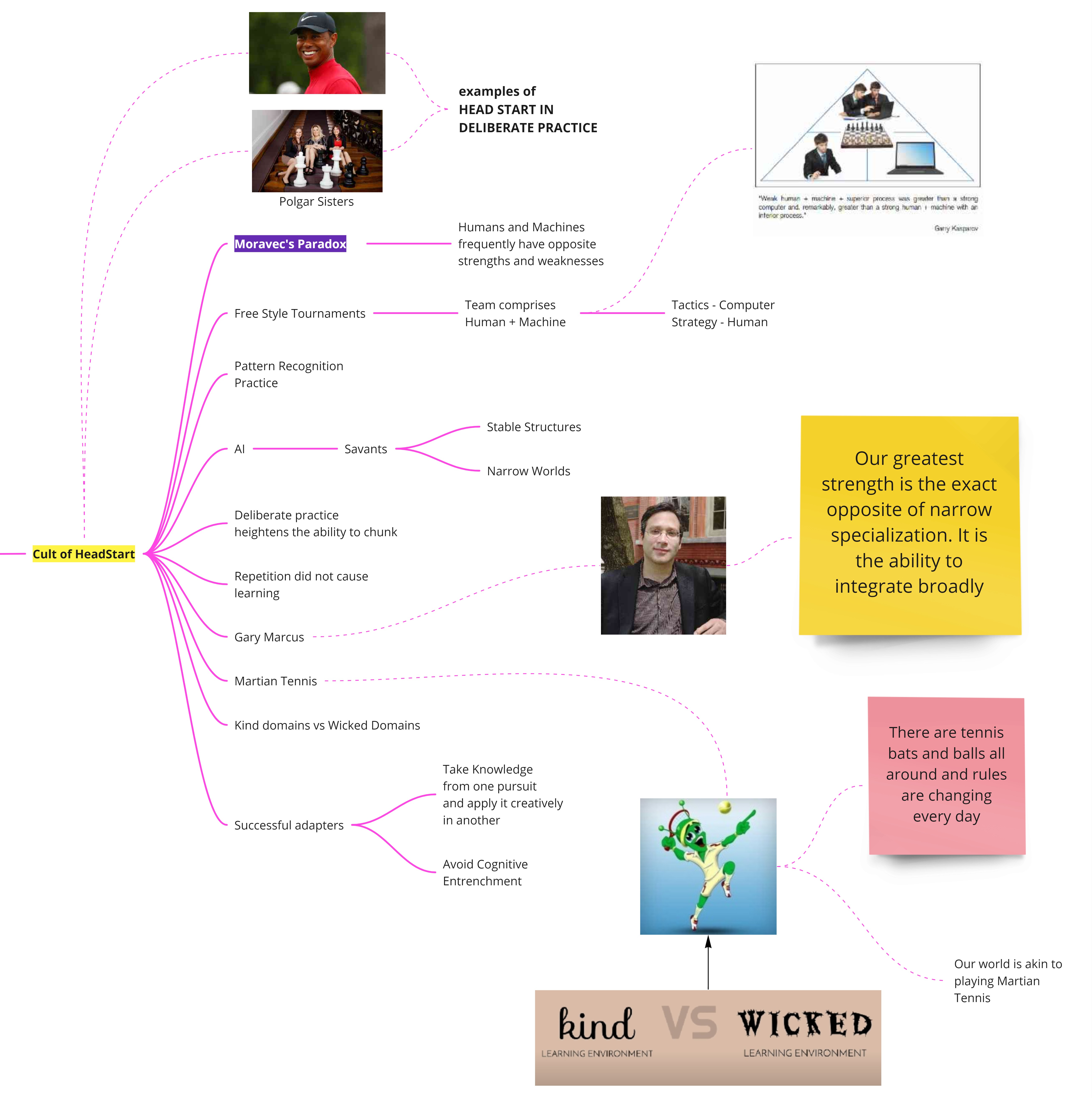
The Cult of Head Start
The chapter delves in to the lives of Polgar sisters who became chess grandmasters, and whose success has been analyzed by many books that tout the 10,000 hour deliberate practice theory. The problem with paying too much attention to chess and extrapolating it to the other domains is that latter are very different from narrow rule based domains such as chess or golf. The author says that there are two kinds of learning environments - kind learning and wicked learning. In the former, there are set rules and constraints that every player must follow. In the latter, the environment is similar to playing “martian tennis”, a term to connote a game where there are lots of players and rackets on a tennis court but the rules are not mentioned. Our world is dominated by wicked learning environments - the author makes a case that all the learning strategies suited to a kind learning environment such as long hours of single minded play, long hours of deliberate practice, zone out everything and keep at a task day after day - might not be useful in wicked learning world
Connolly’s primary finding was that early in their careers, those who later made successful transitions had broader training and kept multiple “career streams” open even as they pursued a primary specialty. They “traveled on an eight-lane highway,” he wrote, rather than down a single-lane one-way street. They had range. The successful adapters were excellent at taking knowledge from one pursuit and applying it creatively to another, and at avoiding cognitive entrenchment. They employed what Hogarth called a “circuit breaker.” They drew on outside experiences and analogies to interrupt their inclination toward a previous solution that may no longer work. Their skill was in avoiding the same old patterns. In the wicked world, with ill-defined challenges and few rigid rules, range can be a life hack.
Pretending the world is like golf and chess is comforting. It makes for a tidy kind-world message, and some very compelling books. The rest of this one will begin where those end—in a place where the popular sport is Martian tennis, with a view into how the modern world became

How the Wicked World was made
The author says that our current world is a wicked world, in the sense that,
procedural knowledge is not enough. Our ability to thrive in this world requires
conceptual reasoning skills, requires us to connect new ideas and work across
contexts. Most of the chapter goes in to explaining “James Flynn” effect. Well,
I think the biggest takeaway is the we need to have good “fermi-skills” or
“guesstimation” skills to understand and make sense of the world around us. When
I read this book a few years ago; Back then, I realized that my guesstimation
skills were pathetic. Took some time around and then invested some time
consciously to improve them. All credit goes to this book for putting me on the
path of “developing fermi-skills”. There were brief period of time when I did
focus on developing “guesstimation skills” but never developed a healthy ritual
around it. Fast forward now, I have put in a daily ritual so that I get a chance
to improve on “fermi-skills”. I try to make it a dailyish activity so that it is
not something that I revisit whenever I feel I am out of touch. I have also
tried something different. These days when I go for long walks, I picked up
Anki app , loaded with a bunch of numeracy related skills and end up working
on Fermi Skills for an hour in my long walk. As someone said, the best way to
inculcate a habit is to incorporate it in to something that you already do on a
daily basis. I tend to “Walk” daily and log in atleast 90 to 120 min every day.
I have found doing Anki in my walk also has an added benefit. Some of the
numbers in my mind are now associated with specific landmarks in my daily walk.
Hence it is that much more easier to recollect. Anyways, I have digressed quite
a bit. Coming back to this chapter, here is a mindmap of some of the points
mentioned:
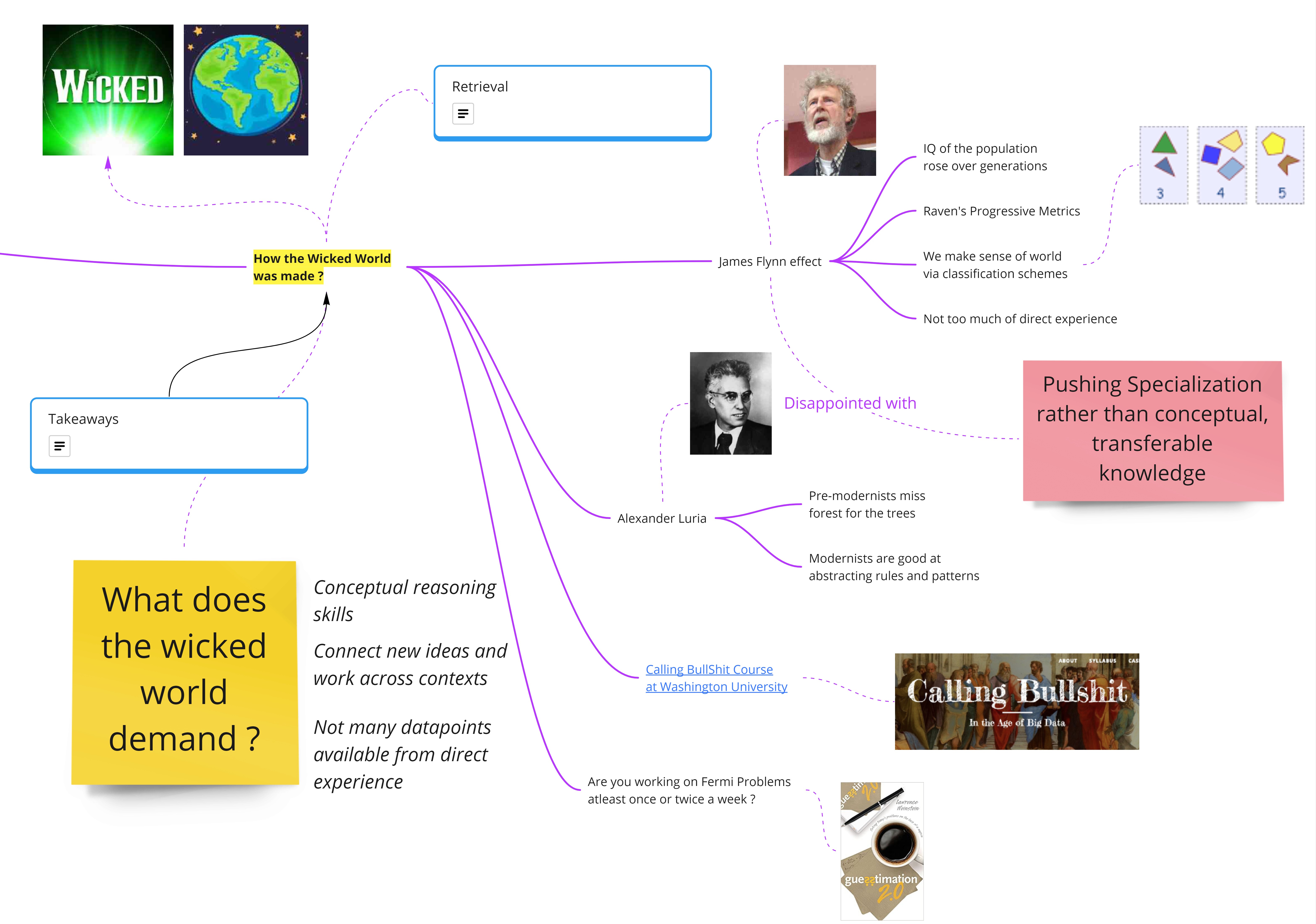
When Less of the Same is More
The chapter narrates the stories of several famous personalities to highlight the meandering path that each took to achieve mastery and fame in a specific discipline.
The chapter begins with the story of orphans abandoned by Venetian sex workers and tries to answer the question
Just what magical training mechanism was deployed to transform the orphan foundlings of the Venetian sex industry, who but for the grace of charity would have died in the city’s canals, into the world’s original international rock stars?
The Pietà’s music program was not unique for its rigor. According to a list of Pietà directives, formal lessons were Tuesdays, Thursdays, and Saturdays, and figlie were free to practice on their own. Early in the rise of the figlie del coro, work and chores took most of their time, so they were only allowed an hour a day of music study.
The most surprising feature was how many instruments they learned. Shortly after he received his music doctorate from Oxford, eighteenth-century English composer and historian Charles Burney set out to write a definitive history of modern music, which involved several ospedali visits. Burney, who became famous as both a travel writer and the foremost music scholar of the day, was astounded by what he saw in Venice. On one ospedali trip, he was given a two-hour private performance, with no curtain between him and the performers. “It was really curious to see, as well as to hear, every part of this excellent concert, performed by female violins, hautbois [oboes], tenors, bases, harpsichords, french-horns, and even double bases,” Burney wrote. More curious still, “these young persons frequently change instruments.”
But the strategies of their musical development would be a hard sell. Today, the massively multi-instrument approach seems to go against everything we know about how to get good at a skill like playing music. It certainly goes against the deliberate practice framework, which only counts highly focused attempts at exactly the skill to be performed. Multiple instruments, in that view, should be a waste of time.
The above story touts sampling theory and range rather than sticking to just one instrument through out one’s musical journey
The author then goes on to cite the research of John Sloboda to emphasize
When Sloboda and a colleague conducted a study with students at a British boarding school that recruited from around the country—admission rested entirely on an audition—they were surprised to find that the students classified as exceptional by the school came from less musically active families compared to less accomplished students, did not start playing at a younger age, were less likely to have had an instrument in the home at a very young age, had taken fewer lessons prior to entering the school, and had simply practiced less overall before arriving—a lot less. “It seems very clear,” the psychologists wrote, “that sheer amount of lesson or practice time is not a good indicator of exceptionality.” As to structured lessons, every single one of the students who had received a large amount of structured lesson time early in development fell into the “average” skill category, and not one was in the exceptional group. “The strong implication,” the researchers wrote, is “that that too many lessons at a young age may not be helpful.”
However,” they added, “the distribution of effort across different instruments seems important. Those children identified as exceptional by [the school] turn out to be those children who distributed their effort more evenly across three instruments.” The less skilled students tended to spend their time on the first instrument they picked up, as if they could not give up a perceived head start. The exceptional students developed more like the figlie del coro. “The modest investment in a third instrument paid off handsomely for the exceptional children,” the scientists concluded.
A beautiful quote from Jack Cecchini
I could show somebody in two minutes what would take them years of screwing around on the fingerboard like I did to find it. You don’t know what’s right or what’s wrong. You don’t have that in your head. You’re just trying to find a solution to problems, and after fifty lifetimes, it starts to come together for you. It’s slow,” he told me, “but at the same time, there’s something to learning that way.
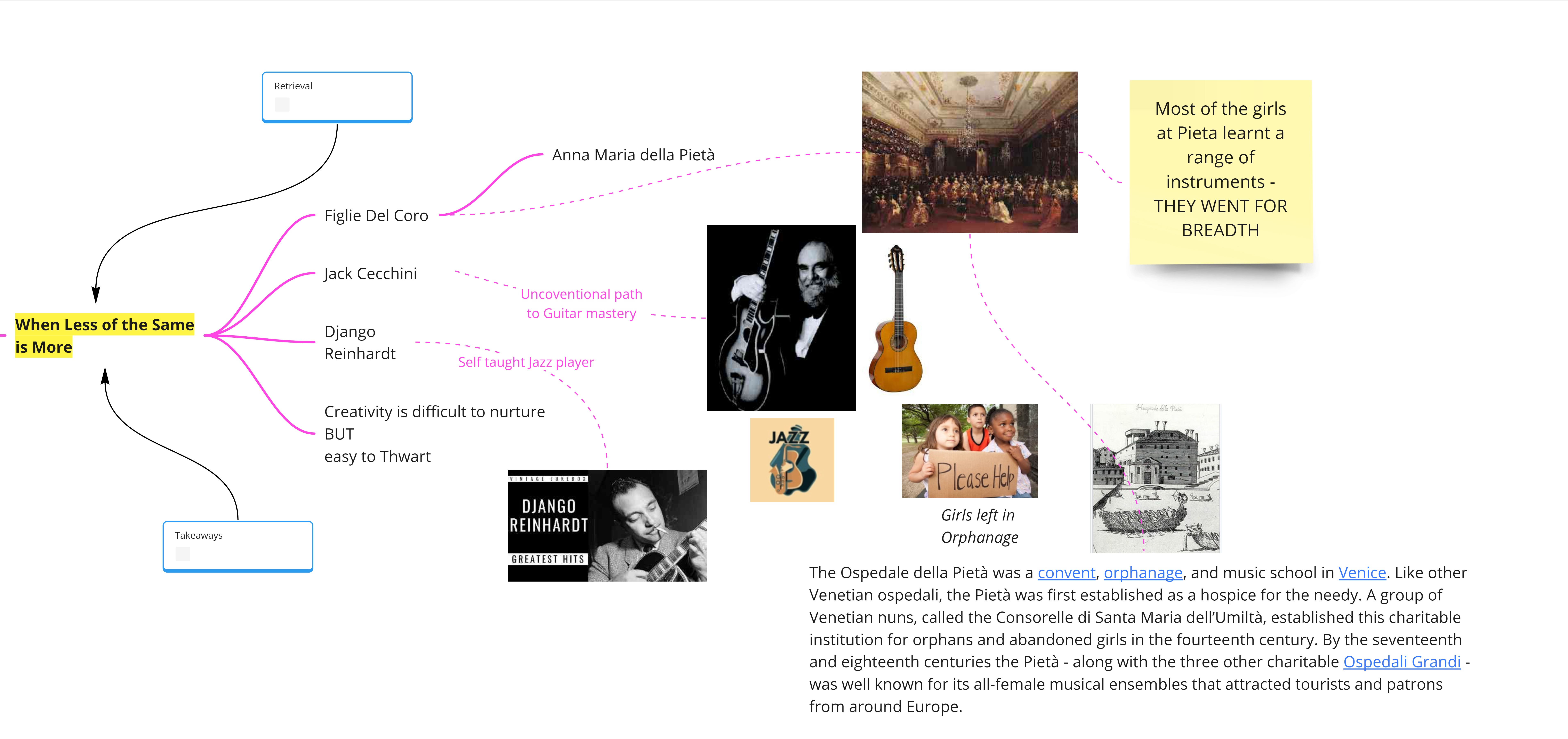
Learning Fast and Slow
The chapter starts off with taking us to a elementary school setting where the teacher is trying to teach a lesson from the syllabus, “evaluating expressions”, to a bunch of students. Based on a series of dialogues between the teacher and students, it becomes clear the students are getting adept are recognizing the procedural aspects of math. They are getting good at converting the problems to various procedures so that they can answer the relevant question. This kind of knowledge is prevalent in most of the schools across the world. The teacher introduces the lesson, teaches the students certain procedures to solve a few problems. In the worksheets that follow, usually there are a set of problems that the kids answer. To answer the practice tests or worksheets, the students invoke procedural knowledge. It all looks ok but in the longer term, this knowledge is very fleeting. By merely able to regurgitate the procedural math, the students lose the ability to make connections. Even in the case where the student tries to bring home the importance of connections, there is an issue. The instructor usually follows it up with a relevant procedural knowledge required to solve the problem. There are no open ended questions. There are no dead ends. There is no scope for exploration for the students.
This kind of fast and efficient learning is what plagues the modern education system. For every problem, instead of letting the core ideas lurk in a student’s mind, instead of highlighting the open ended questions, instead of making it difficult, the purpose of educations, it seems, is to offer recipes. These recipes might give the student enough ammunition to ace the quizzes or exams that follow. However ample empirical research on this topic shows the students long term retention and comprehension skills are improved ONLY if the material is difficult to, ONLY when the learning is slow and tough.
As a contrast, Japanese education focuses on making connections and highlighting connections among various ideas, whatever be the concept that is taught in the school. Bansho - Connection blackboards are very popular in the classroom setting where the instructors make sure that they highlight open-endedness, exploratory nature of knowledge understanding, deadends. But bringing all these type of connections infront of students, everyone admits that procedural questions and connection exploring questions are both required for active learning.
Teachers and students must avoid interpreting current performance as learning. Good performance on a test during the learning process can indicate mastery, but learners and teachers need to be aware that such performance will often index, instead, fast but fleeting progress
The other aspects of active learning highlighted are interleaving and generation effect. The former highlights the importance of mixing blocked practice across similar topics or diverse topics so that your subconscious brain has enough time to mull over the topics. In professional life, this is all the more important if your job prices breadth instead of/ along with depth. There are many times when we feel that we should focus on one aspect and get all the related concepts in place before we move on to another learning topic. Often our professional needs us to move from one deliberate to another, and more often than not these deliverables might not be connected. In all such work environments, it is important to carve out time and firstly engage in blocked practice. However there is no point in doing blocked practice on a specific topic for an extremely long period. It makes sense to bring variety in the blocked practice schedule. In my own case, I have found that after going through an immersion on a topic for a few days or weeks, I move on to something else deliberately. One should always move to another topic with the lingering thought that you will revisit the topic at a latter point in time. Almost a decade, I remember immersing in measure theory and interleaving the topic by working through various books that focused on one specific aspect of measure theory. It took me a while but that slow and seemingly inefficient short term learning has made the concepts stick. After almost 12 years since I understood the topic, I can easily write a 50 page book on measure theory with ease. This is just one instance in my own life. There are often less demanding concepts, knowledge areas that one can ace through, if one follows blocking, spacing, interleaving, frequent testing techniques.
Another frequent mistake from the students and community around the schools is that instructors who manage to get the students higher scores on immediate tests such as quizzes, annual exams are rated favorably over teachers whose classes are difficult to comprehend, open ended. In a way, our focus on short term results in good teachers getting a bad rap.
The author takes a dig at all “headstart” programs that talk about churning kids in to geniuses. All these programs focus on imparting skills that are mostly procedural and not connection oriented. At the end all such programs, the kids might be able to ace certain quick tests but overall these skills wane quickly or others catch up to these skills.
If programs want to impart lasting academic benefits they should focus instead on “open” skills that scaffold later knowledge. Teaching kids to read a little early is not a lasting advantage. Teaching them how to hunt for and connect contextual clues to understand what they read can be. As with all desirable difficulties, the trouble is that a head start comes fast, but deep learning is slow. “The slowest growth,” the researchers wrote, occurs “for the most complex skills.”
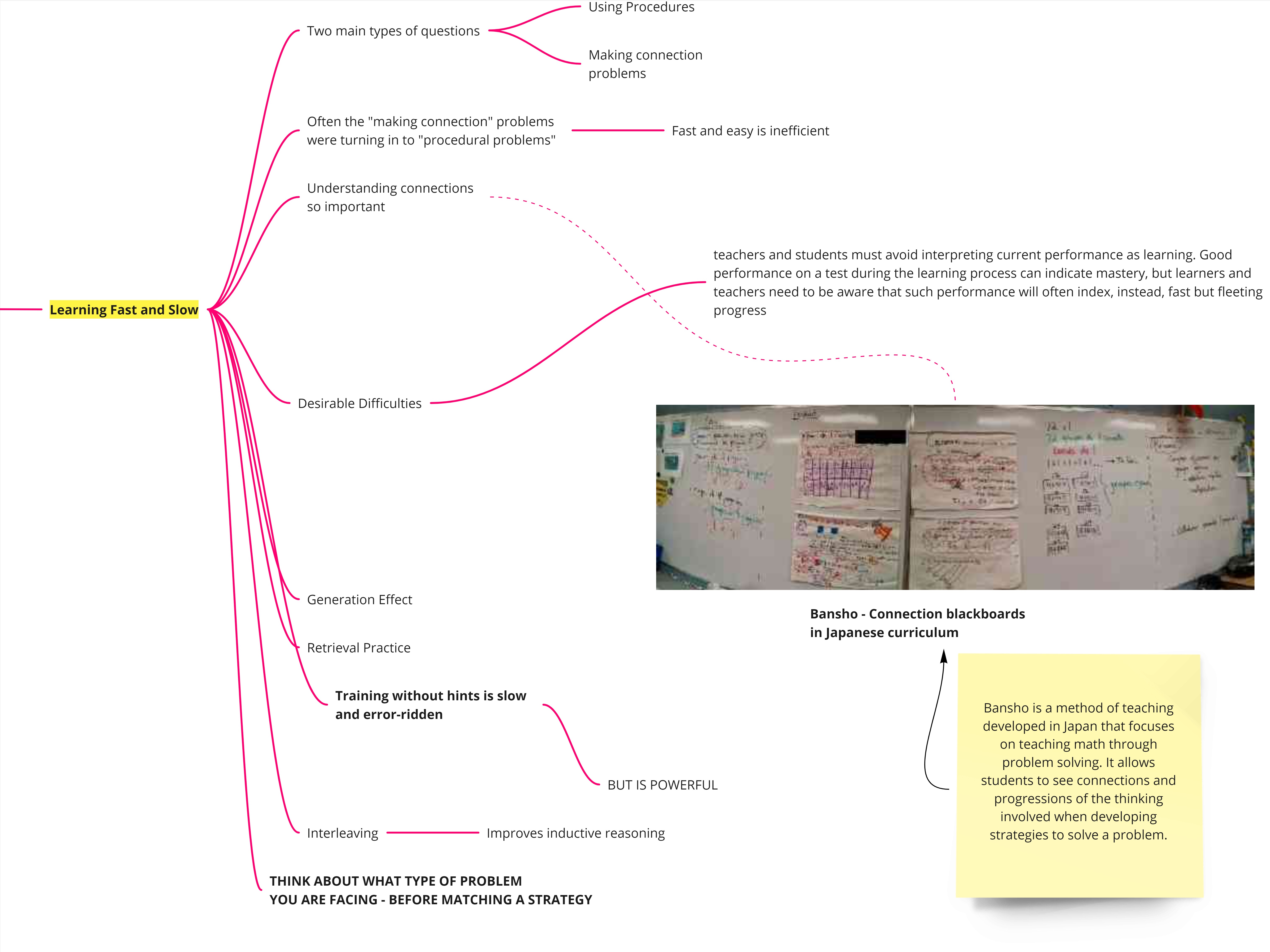
Thinking Outside Experience
This chapter highlights the importance of “knowledge” that resides outside the gamut of “expert knowledge” that can be super useful to solve problems. Keplar’s life provides a great example of it. He was forever using analogies to think through difficult issues, that eventually helped in coming up the three laws of planetary motion.
The chapter highlights the importance of culling out examples or patterns from neighboring fields in order to solve a problem in a specific field. Kevin Dunbar’s research shows that the best labs in the world comprise of people who have Kepler’s mindset, i.e. willing to challenge assumptions and look for things far away from one’s field for inspiration, tinkering, testing and iteration.
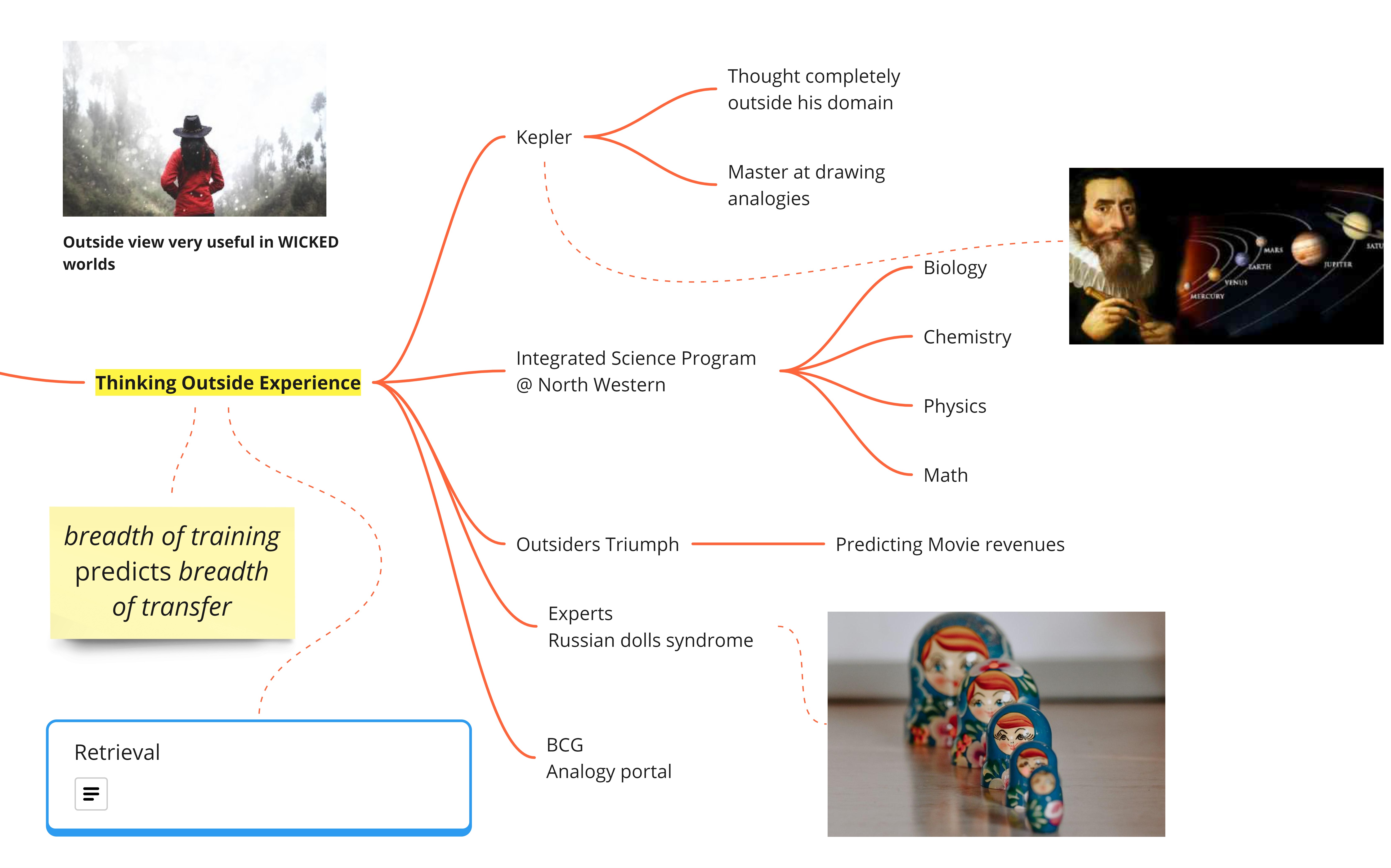
Trouble with too much grit
The chapter talks about some of our tendencies to over estimate the importance of “grit” in the success of an individual. There are many books, papers, blogposts and tweets about individuals sticking to and doing something despite all odds and eventually succeeding. We make a virtue out of it, which is what the author is against. The theme resonated in this chapter is no different from the previous chapters, but the catch phrase used in all the chapters is “Match Quality”. The author uses the example of Vincent van Gogh to illustrate the importance of sampling various items in life. It is important that one gets to sample various types of work before spending considerable amount of time on any specific task or domain or technology. The author also uses Angela Duckworth’s book on Grit, which seemed to have spawned a lot of interest on the subject, to reiterate the fact that the successful cadets leave the academy because they understand the importance of match quality.
There are many more personalities mentioned in the chapter who say - “Switching works”. From my personal life, there are tons of times I have switched works. I think the biggest difference has been that I have always put in a lot of prep work before I switch. Let’s say I know that I want to work on XYZ for 6 months that fetches revenue to the company; I put in the initial effort to understand the principles and may be get a rough idea of the skills needed to deliver XYZ. In a sense, I am not sure whether random sampling without prep to deliver or work on that task helps. The chapter’s subtle message is that - you don’t have to think about prep work - jump in to the task and you will anyway learn from it. May be, May be not.
The benefits to increased match quality outweigh the greater loss in skills.” Learning stuff was less important than learning about oneself. Exploration is not just a whimsical luxury of education; it is a central benefit.
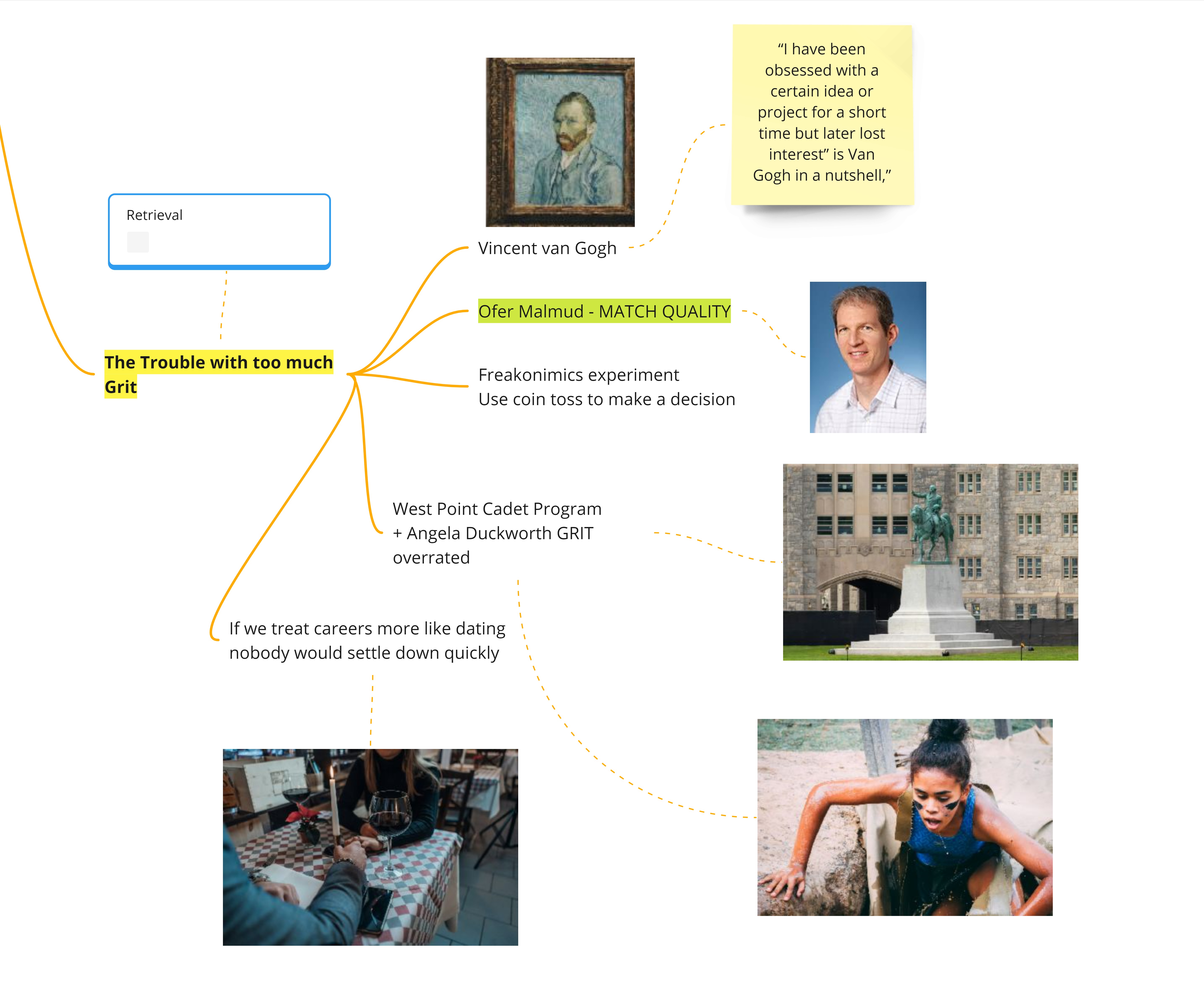
Flirting with Possible Selves
The chapter gives a bunch of examples of people who were exploring their own likes or dislikes, before doing something substantial in a field of their choice. The emphasis is always on the method, i.e. sampling various types of work for understanding themselves better. The mindmap below gives a quick summary of the people mentioned in the chapter - all of whom are late starters and explorers
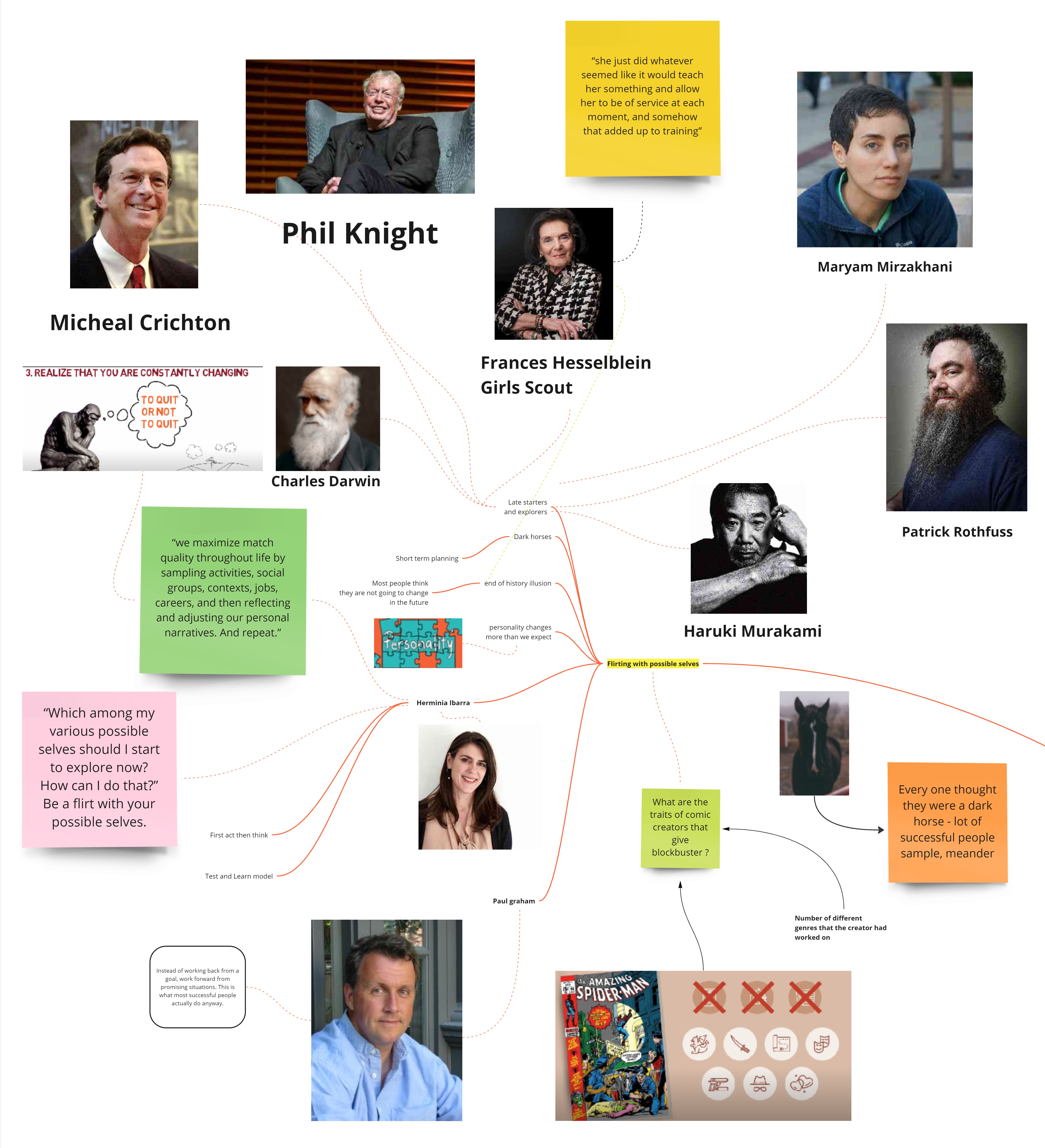
The key takeaway from this chapter is
First act, then think. We discover the possibilities by doing, by trying new activities, building new networks, finding new role models. We learn who we are in practice, not in theory.
This might seem counterintuitive to what most of us would have learned - always think before you act. However in this context it says that the only way to understand your strengths and weaknesses, likes and dislikes, propensity to quit, propensity to stay put is actually doing the activity. Indulgence in surveys, questionnaires, frameworks might seem as a way to understand ourselves better. May be they are. But “acting and learning about the how we feel about the action” trumps it all.
There is a definitive edge in specializing as you tend to remove distractions and focus on just one thing. But that edge becomes a double edge sword if you have not had a chance to flirt with your possible selves.
Some of the interesting quotes from this chapter are
Frances Hesselblein did whatever seemed like it would teach her something and allow her to be of service at each moment, and somehow that added up training.
Dark horses were on the hunt for match quality. They never look around and say, “Oh, I’m going to fall behind, these people started earlier and have more than me at a younger age”. They focused on, “Heres who I am at the moment, here are my motivations, here’s what I’ve found I like to do, here’s what I’d like to learn, and here are the opportunities. Which of these is the best match right now? And maybe a year from now, I’ll switch because I’ll find something better.”
In the last several years, I have been following the above dictum. There are many aspects of my task that are new to me when I moved to a new place, new company, new role. For a person who was completely an introvert, getting in to more front office customer facing role was different. It is not that I lacked confidence, it was more on “whether I should be doing this at all” ? I have over a period of time, thanks to the way life has lead me, tried understanding several aspects be it in the tech space, data space, modeling space. The breadth is something that I have gained over the last 10 years. Understandably, it is difficult to make a case for breadth when the world around wants us to pigeon hole based on specific job titles, business domains etc. But I think one can consciously switch off those external influences and have a spirit as echoed by the above mentioned quote
Standardization covenant - Cultural notion that it is rational to trade a winding path of self-exploration for a rigid goal with a head start because it ensures stability. “The people we study who are fulfilled do pursue a long-term goal, but they only formulate it after a period of discovery.”
Dan Gilbert on “end of history illusion”: We are all works in progress claiming to be finished.
A person doesn’t know what he can do unless he tries. Tying things is the answer to find your talent
“Test and learn” - Not “plan and implement”
All of the strengths-finder stuff, it gives people license to pigeonhole themselves or others in ways that just don’t take in to account how much we grow and evolve and blossom and discover new things. But people want answers, so these frameworks sell. It’s a lot harder to day, “Well, come up with some experiments and see what happens”
The Outsider Advantage
The chapter weaves a narrative across personalities who have ventured outside their narrow field to create breakthrough solutions. Emphasizes the need to look outside one’s core area of work to make connections, create analogies.
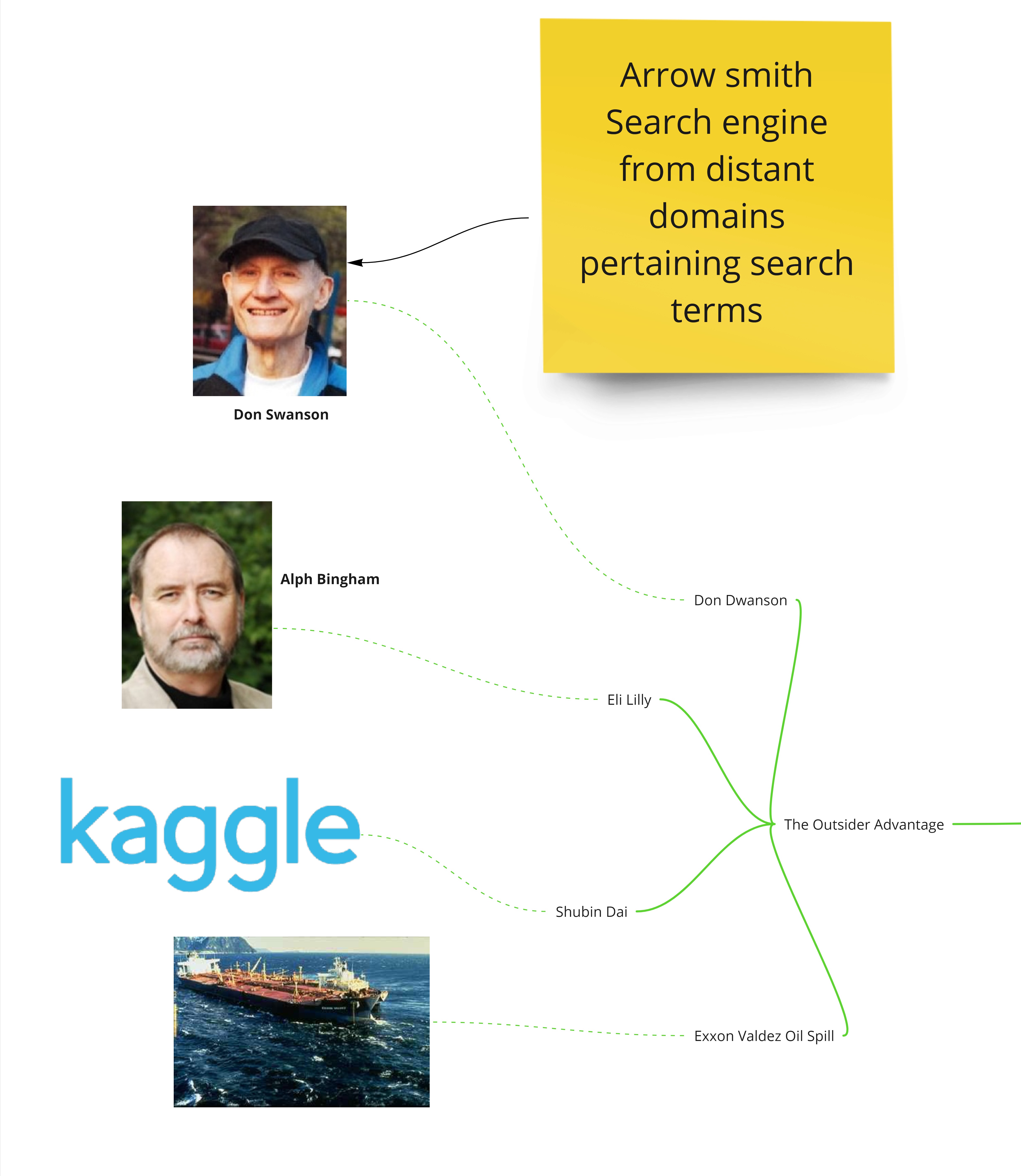
Lateral thinking with Withered Technology
The chapter talks about several personalities who have made significant contributions by connecting across various disciplines. Gunpei Yokoi, Andy Ouderkirk and Jayshree Seth emphasize the importance of seeking breadth as well as our innate desire to focus and become good in a specific area.
Specialization is obvious: keep going straight. Breadth is trickier to grow. A subsidiary of PricewaterhouseCoopers that studied technological innovation over a decade found that there was no statistically significant relationship between R&D spending and performance.* (Save for the bottom 10 percent of spenders, which did perform worse than their peer companies.) Seeding the soil for generalists and polymaths who integrate knowledge takes more than money.
Abbie Griffin on Serial innovators/entrepreneurs:
- high tolerance for ambiguity; systems thinkers
- additional technical knowledge from peripheral domains
- repurposing what is already available
- adept at using analogous domains for finding inputs to the invention process
- ability to connect disparate pieces of information in new ways
- synthesizing information from many different sources
- they appear to flit among ideas; broad range of interests
- they read more (and more broadly) than other technologists and have a wider range of outside interests
- need to learn significantly across multiple domains
- Serial innovators also need to communicate with various individuals with technical expertise outside of their own domain.
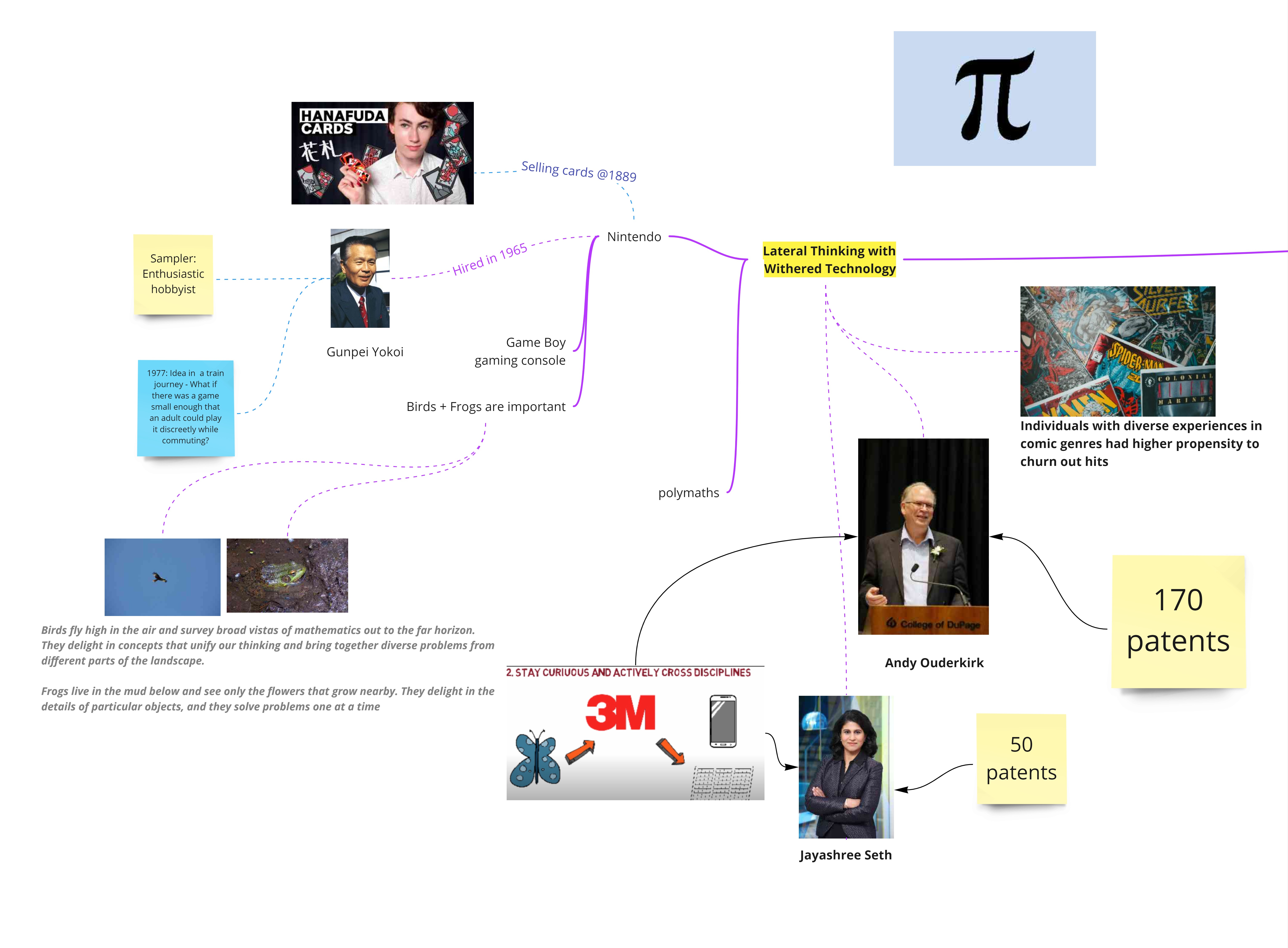
Fooled by Expertise
The content of this chapter is somewhat familiar to me as there have been a ton of books written on the importance of being a fox rather than a hedgehog. I read the book “Superforecasting” 8 years ago and blogged about it here. The chapter does a nice job of summarizing the importance of flexible thinking. Back then, I was fascinated by Bayesian thinking and the fact that Bayesian stats offers a nice systematic way of updating one’s beliefs. Somehow I never got a chance to formally employ Bayesian techniques in real life, i.e. predict something and then update the priors based on real life data. Even though I understand the principles of Bayesian stats, sometimes I wonder, what is the use of it, if I have never actively thought about applying in the real world by participating in some prediction event ? Why have I not applied the principles in trading ? May be someday I will. Anyways coming back to this chapter, I find that most of the guidelines mentioned in the book fall can be summarized as
- Develop flexible thinking
- Indulge in foxy training every day. An hour of training each day improves your skills massively
- Actively seek out people, resources, books that challenge your assumptions
- Be at peace with uncertainty
- You can do an about turn on your beliefs if the world changes around you or facts point in the direction
- Dissect all the bad outcomes and create a feedback even if the wicked world does not give one
- Foxes see complexity in what others mistake for simple cause and effect. They understand that most cause-and-effect relationships are probabilistic, not deterministic
- Most science-curious folk always chose to look at new evidence, whether or not it agreed with their current beliefs
- Best forecasters view their own ideas as hypotheses in need of testing.
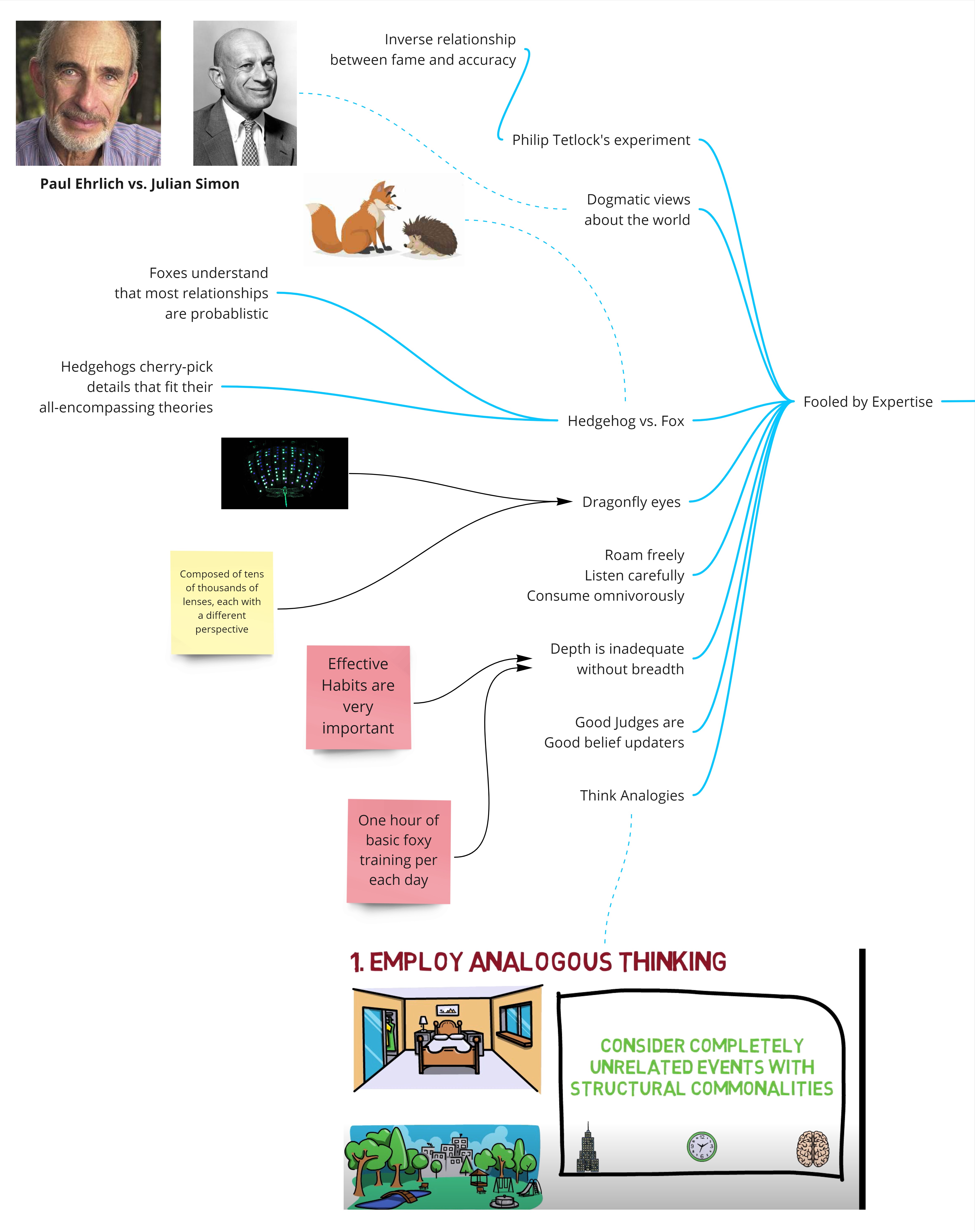
Learn to Drop your familiar tools
This chapter is similar to the previous one in a sense. The earlier chapter focused on flexibility of mental models. This chapter focuses on having flexibility in choosing the tools. Too much of reliance of quant tools is bad. And so is too much reliance of qual tools. One needs both tools to survive and get better at a job.
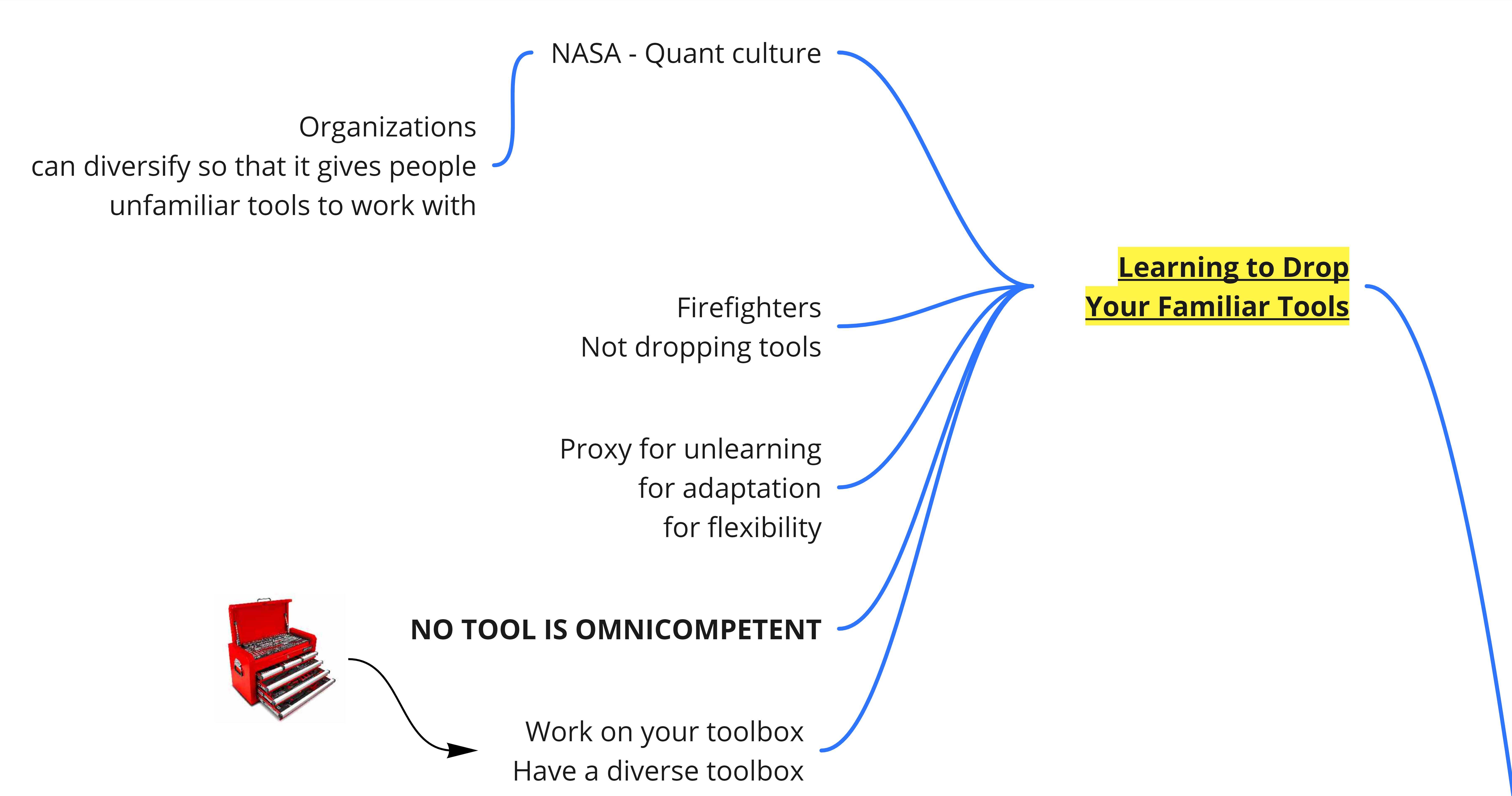
Deliberate Amateurs
The chapter narrates the stories of several nobel laureates, scientists, researchers around the world who have made significant contributions to “specific” fields; the theme being that all these personalities had set up their schedule to deliberately play with things outside their own field. Some set up weekly schedules to get this done, Some dipped in to ancient traditional medicine, some chose to read across disciplines on a regular basis.
I guess by the end of the chapter, you will start questioning your own life on whether you are actively incorporating outside knowledge, whether you are spending time on learning things form outside your immediate area of work, whether you are tinkering on a daily basis. Books such as should be reread from time to time so that our brain internalizes most of the fascinating points mentioned in the book. My gut feel says that, by following a few principles or hacks mentioned in this chapter, there can be great transformation in the way you might lead your life.
Take your skills to a place that’s not doing the same sort of thing. Take your skills and apply them to a new problem, or take your problem and try completely new skills.
Uzzi and a team analyzed eighteen million papers from a variety of scientific domains to see whether atypical knowledge combinations mattered. If a particular paper cited other areas of research that rarely, if ever, appeared together, then it was classified as having used an atypical combination of knowledge. Most papers relied purely on conventional combinations of previous knowledge. That is, they cited work from other journals that often appeared together in other studies’ lists of references. The “hit” papers, those that over the next decade were used by a huge number of other scientists, featured ample conventional combinations, but also added an injection of unusual knowledge combinations.
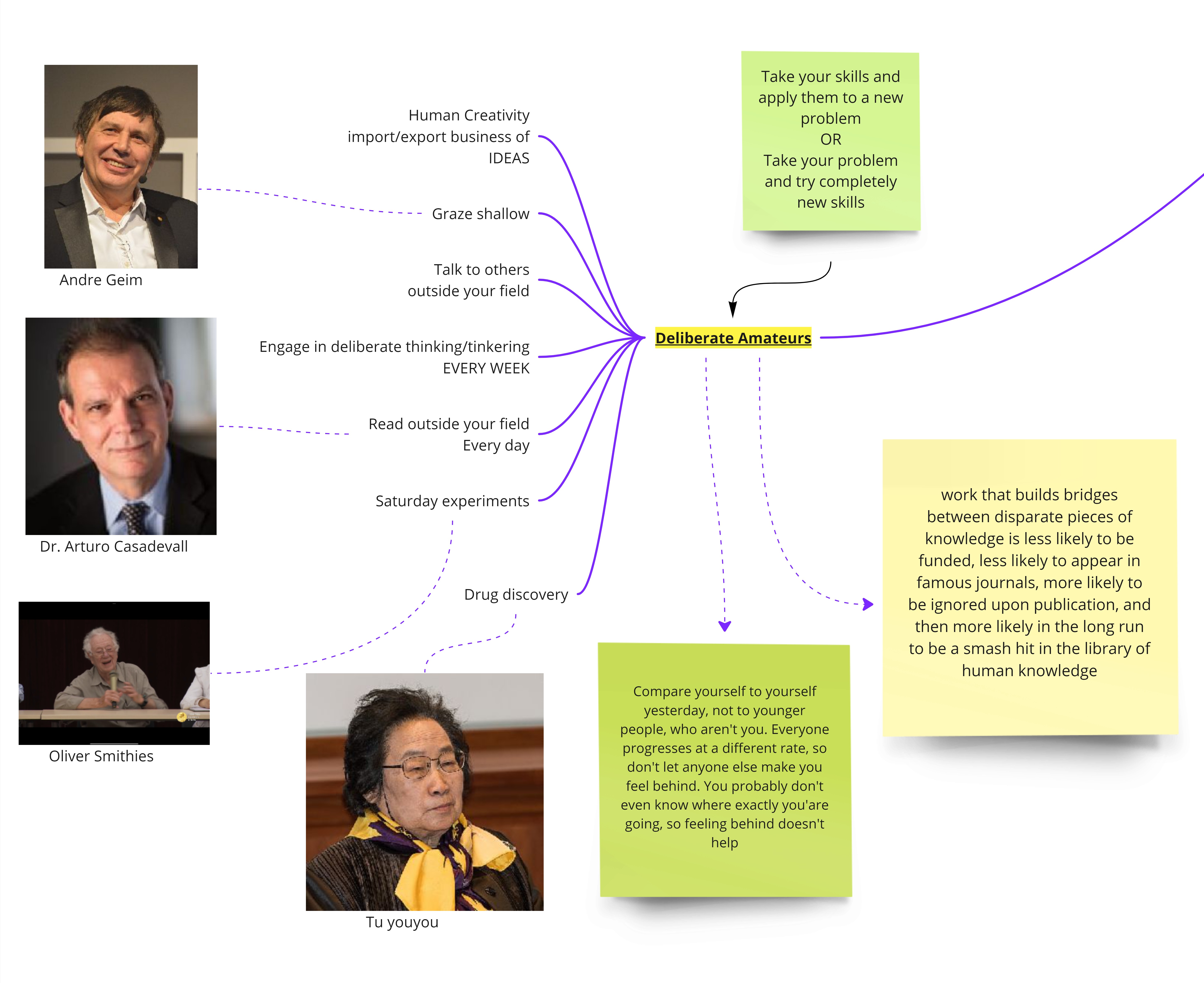
Takeaway
This is my second time reading this book and it was worth every minute of it. When I had first read the book a few years ago, I had internalized a few of the principles from the book and had started to inculcate a few habits. This time around, after spending a few years being a generalist, I have realized that there are a ton of other aspects that I missed in my first read. Thoroughly enjoyed it. May be I will read this book a few years from now and my guess I will find it as refreshing as ever.